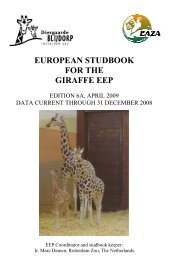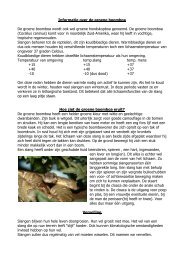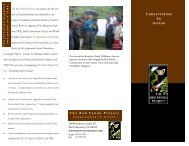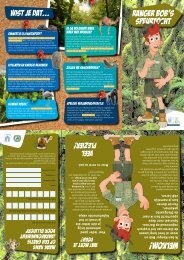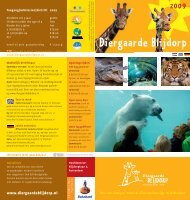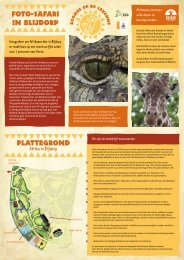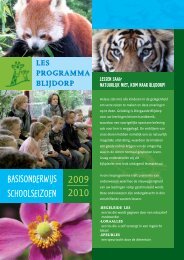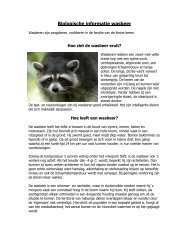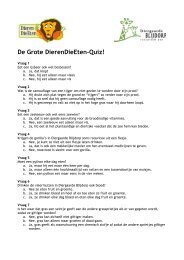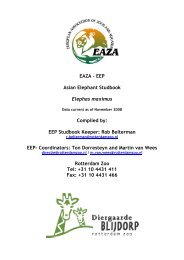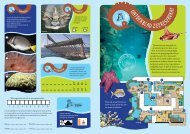Create successful ePaper yourself
Turn your PDF publications into a flip-book with our unique Google optimized e-Paper software.
<strong>EEP</strong> STUDBOOK CROWNED PIGEONS<br />
But for example all passerine and the remaining non-passerine taxa are almost certainly<br />
derived from Asian colonists to New Guinea and Australia. A conclusion based on the<br />
relatively more modern fossil history of these groups or their close phylogenetic ties with taxa<br />
in Australia, or both (Pratt, 1981). A <strong>number</strong> of boundaries have been placed on<br />
biogeographic maps of the region to try and indicate, for instance, the most western boundary<br />
of the truly Australasian fauna and flora (Wallace’s Line) or the border of shallow sea to the<br />
west of New Guinea (Lydekker’s Line). The first scientist to have studied the phenomenon<br />
was Alfred Russell Wallace in the late 19 th century and, in his honour, the region of faunal<br />
mixing between Wallace’s Line and Lydekker’s Line is sometimes called ‘Wallacea’<br />
(Menzies, 1991).<br />
At the edge of the two plates, New Guinea is tectonically active, with a considerable history<br />
of mountain-uplift, volcanic activity, and earthquakes. Today this is a still continuing proces<br />
(Beehler, et al., 1986) and in 1995, Madang, a city on the northcoast of Papua New Guinea,<br />
was almost completely destroyed by an earthquake.<br />
Many aspects of New Guinea’s topography indicate geological youth: ungraded rivers, Vshaped<br />
valleys, waterfalls, cliffs, and frequent land slippage. This unstable topography makes<br />
road building difficult and frustrates regional development. The island is highly mountainous,<br />
with 66 percent of the land more than 300m above sea level, and 14 percent higher than 1,500<br />
m (Beehler, et al., 1986).<br />
In New Guinea several different geographical subregions can be distinguished, each with<br />
some characteristic flora and fauna. The region which is most obviously different from the<br />
rest of New Guinea is the southern woodland or savanna country, which includes many<br />
elements of the Australian fauna. This region includes the plains of the southern Fly and<br />
Digul Rivers, a narrow coastal strip east and west of Port Moresby and some scattered patches<br />
on the southeast coasts. The animals found here are all common in North Queensland<br />
(Australia) and their presence in New Guinea is a relic of the time when Australia and New<br />
Guinea were one land mass, before the Torres Strait was formed. Relatively a few species are<br />
found in both savanna and forest.<br />
Most of the rest of New Guinea is covered by a tropical rain forest of various species and can<br />
be divided into different zones, the exact boundaries of which vary from place to place<br />
according to local climate and topography. Lowland forest from sea level to about 600m is<br />
often struck by inundation. Hill forests on slopes up to 1000 or 1200 m have a similar<br />
composition but are not struck by inundation in wet weather. Lower montane forest (1200 to<br />
2000m), mid-montane forest (2000-3000m) and upper montane forest above 3000m follows,<br />
but upper montane forests tend to occur in patches interspersed with open vegetation of grass,<br />
sedges and shrubs. With increasing altitude the forest patches and the trees themselves<br />
become smaller and smaller and finally peter out about 3900m.<br />
Lowland and hill forests are further subdivided into northern and southern regions because the<br />
central mountain chain which runs from one end of the island to the other forms a barrier as<br />
there are no low altitude passes from north to south (Beehler, et al., 1986). These zones each<br />
have some characteristic animals, while other animals are widespread through several zones<br />
(Menzies, 1991).<br />
86



